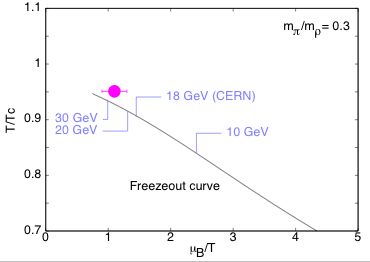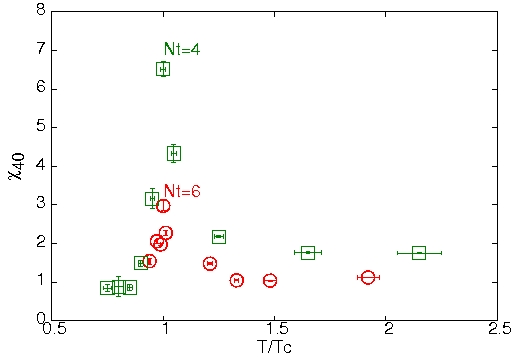A critical point of QCD
We have found the critical end point in 2 flavour QCD (circle in purple) through the analysis of a Taylor expansion of the quark number susceptibility in the baryon chemical potential μB.
Publications
- Phys. Rev. D 78, 114503, 2008
- Phys. Rev. D 73, 014004, 2006
- Phys. Rev. D 72, 054006, 2005
- Phys. Rev. D 71, 114014, 2005
- Phys. Rev. D 68, 034506, 2003
Talks
- Critical Point and the Onset of Deconfinement, BNL, 2009
- The QCD Critical Point, INT Seattle, 2008
- Extreme QCD, NCSU, 2008
- Quark Matter, 2008
- Strong and Electro-Weak Matter, 2006
- Strangeness in Quark Matter, 2006
- Lattice 2005
- QCD and Dense Matter: From Lattices to Stars, INT Seattle, 2004: Part 1 and Part 2
- Workshop on Finite Density QCD, Nara, 2003
- Lattice 2003
Projects available
Masters' projects
Reworking lattice QCD methods to work on parallel computers is necessary in order to enhance computational abilities in future. This work can be done by masters' students in physics as well as applied mathematics. If you would like to do such a project for your masters' thesis, then you should have good understanding of either quantum field theory or an object oriented programming language such as C++ or Fortran 90. It would be an advantage to know both. If you are interested write to ilgti at theory fullstop tifr dot res period in.
Bachelors' projects
The phase diagram of QCD is a seven-dimensional object. It would be interesting to write a program to take sections and projections of this object in any specified plane and draw the corresponding graph. Knowledge of either phase transitions or graphics programming is a pre-requisite for this project.
Quark number susceptibilities
The fourth order quark number susceptibility χ40 peaks close to Tc. This is closely related to the "Kurtosis" signal for the critical end point. The fourth (and higher) order susceptibilities were first introduced by us in 2003.
Publications
- Phys. Rev. D 78, 114503, 2008
- Phys. Rev. D 73, 014004, 2006
- Phys. Rev. D 72, 054006, 2005
- Phys. Rev. D 68, 034506, 2003
- Phys. Rev. D 67, 034501, 2003
- Phys. Rev. D 65, 094515, 2002
- Phys. Rev. D 65, 054506, 2002
- Phys. Rev. D 64, 074506, 2001
Projects available
Masters' projects
The study of quark number susceptibilties is the most direct signal of the critical end point of QCD. There are straightforward algorithms to generate the quantum field operators which go into determining some of the as yet uncomputed ones. This work can be done as a summer project.
The study of quark number susceptibilties is the most direct signal of the critical end point of QCD. In order to make contact with experiments, one needs to study the diffusion equation and compute the evolution of the susceptibilties through diffusion. This is a possible Maste's thesis. Parts of this problem can also be done as summer projects.
The Wroblewski parameter

The Wroblewski parameter, λs, as inferred from experiments measures the relative yield of strange and light quarks. It has been measured on the lattice as the ratio of quark number susceptibilities for strange and light quarks. The continuum limit in quenched QCD has been found (brackets are estimates of unquenching errors) and it agrees well with data.

